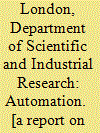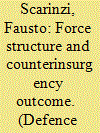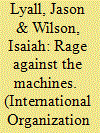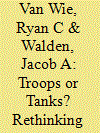|
|
|
Sort Order |
|
|
|
Items / Page
|
|
|
|
|
|
|
| Srl | Item |
| 1 |
ID:
041466


|
|
|
|
|
| Publication |
London, Her Majesty's Stationery Office, 1956.
|
| Description |
viii,106p.
|
|
|
|
|
|
|
|
|
|
|
|
Copies: C:1/I:0,R:0,Q:0
Circulation
| Accession# | Call# | Current Location | Status | Policy | Location |
| 001078 | 629.8/LON 001078 | Main | On Shelf | General | |
|
|
|
|
| 2 |
ID:
178640


|
|
|
|
|
| Summary/Abstract |
This article examines the Cyprus Emergency (1955–1959) to test the force structure thesis. According to the thesis, armies that deploy more manpower per armored vehicle would succeed in counterinsurgency because they could win people’s trust, secure intelligence from civilians, and use force selectively. Using the congruence method of within-case analysis, I show that the causal process and logic of the force structure argument are not confirmed in the favorable case of Cyprus. Despite its preference for infantry and police units, the British garrison failed to win over the people and persuade civilians to share information about the insurgent; besides, Britain’s intelligence breakthroughs and selective violence did not result from the logic of the force structure thesis, nor did the conflict end as the argument would predict. Political conditions, instead, played a greater role. Ultimately, the case of Cyprus warns against the reassuring belief, inherent in the force structure thesis, that military organizational adjustments in favor of manpower can pave the way to victory against irregular opponents.
|
|
|
|
|
|
|
|
|
|
|
|
|
|
|
|
| 3 |
ID:
159080


|
|
|
|
|
| Summary/Abstract |
As the population bonus disappeared, the wage rate has increased significantly since the early 2000s in China. Increasing wages have significantly affected export-oriented industries as well as agriculture. Mechanization is another factor affecting China's agriculture. This study shows the increasing wage and the mechanization have a negative impact on land area devoted to labor-intensive crops but a positive impact on land area devoted to labor-extensive crops. Based on nationally representative data, the empirical results conform well to the theoretical predictions.
|
|
|
|
|
|
|
|
|
|
|
|
|
|
|
|
| 4 |
ID:
159040


|
|
|
|
|
| Summary/Abstract |
Despite small landholdings, a high degree of land fragmentation, and rising labor costs, agricultural production in China has steadily increased. If one treats the farm household as the unit of analysis, it would be difficult to explain the conundrum. When seeing agricultural production from the lens of the division of labor, the puzzle can be easily solved. In response to rising labor costs, farmers outsource some power-intensive stages of production, such as harvesting, to specialized mechanization service providers, which are often clustered in a few counties and travel throughout the country to provide harvesting services at competitive prices. Through such an arrangement, smallholder farmers can stay viable in agricultural production.
|
|
|
|
|
|
|
|
|
|
|
|
|
|
|
|
| 5 |
ID:
090370


|
|
|
|
|
| Publication |
2009.
|
| Summary/Abstract |
During the nineteenth century, states routinely defeated insurgent foes. Over the twentieth century, however, this pattern reversed itself, with states increasingly less likely to defeat insurgents or avoid meeting at least some of their demands. What accounts for this pattern of outcomes in counterinsurgency (COIN) wars? We argue that increasing mechanization within state militaries after World War I is primarily responsible for this shift. Unlike their nineteenth-century predecessors, modern militaries possess force structures that inhibit information collection among local populations. This not only complicates the process of sifting insurgents from noncombatants but increases the difficulty of selectively applying rewards and punishment among the fence-sitting population. Modern militaries may therefore inadvertently fuel, rather than deter, insurgencies. We test this argument with a new data set of 286 insurgencies (1800-2005) and a paired comparison of two U.S. Army divisions in Iraq (2003-2004). We find that higher levels of mechanization, along with external support for insurgents and the counterinsurgent's status as an occupier, are associated with an increased probability of state defeat. By contrast, we find only partial support for conventional power- and regime-based explanations, and no support for the view that rough terrain favors insurgent success.
|
|
|
|
|
|
|
|
|
|
|
|
|
|
|
|
| 6 |
ID:
186971


|
|
|
|
|
| Summary/Abstract |
Are some conventional military units better equipped to conduct counterinsurgency (COIN) operations than others? COIN theorists and practitioners disagree about mechanization’s impact on COIN effectiveness. We suggest that mechanization is not the critical determinant of COIN effectiveness. Rather, mechanization’s effects vary based on a unit’s force employment approach within local scope conditions. To test our hypothesis, we explore how mechanization impacts COIN operations in Ramadi and Basra and find that force employment is the critical determinant in COIN effectiveness. We introduce an adaptive force employment hypothesis that outlines how mechanization includes costs to exposing dismounted troops and benefits in information-sharing, conditional on local insurgent strength. This hypothesis suggests that mechanized forces provide significant benefits to counterinsurgents when clearing high strength insurgents, outweighing benefits from dismounted civilian interaction. Following successful clearance operations when government control is increased and insurgent strength is reduced, requirements for armored protection decrease while civilian tips become increasingly important to target remaining insurgents. In the hold and build stages, counterinsurgents can increasingly rely on dismounted troops.
|
|
|
|
|
|
|
|
|
|
|
|
|
|
|
|
|
|
|
|
|